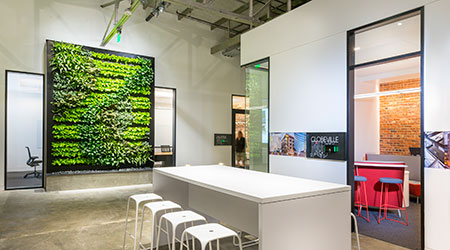 Suite 100 at The Bindery on Blake in Denver, Colo. — the new office space for Davis Partnership Architects — is certified Gold with LEED v4 Interior Design and Construction. The 23,000-square-foot space is one of the largest to be certified under the newest version of the rating system.Paul Brokering ©2016
Suite 100 at The Bindery on Blake in Denver, Colo. — the new office space for Davis Partnership Architects — is certified Gold with LEED v4 Interior Design and Construction. The 23,000-square-foot space is one of the largest to be certified under the newest version of the rating system.Paul Brokering ©2016Find The Biggest Green Interiors Opportunities in LEED v4
Materials selection, energy metering, acoustics, and commissioning can all garner big points in LEED ID+C.
In LEED v4 ID&C, facility and property managers should be aware of all of the potential benefits to be gained by garnering a seat at the table. First and foremost, this is apparent in the new LEED v4 Integrative Process credit. This credit is achieved with an initial analysis of energy and water systems that can identify synergies within the project design in order to optimize energy and water use.
Facility managers will also have an active role in the ID&C Indoor Water Use Reduction credit which awards tenant spaces up to 12 points for exceeding the minimums specified in the Indoor Water Use Reduction prerequisite. Points are earned for every additional 5 percent of potable water savings over the prerequisite, awarding reductions of 20 to 50 percent savings. WaterSense label requirements for plumbing fixtures, previously only recommended in LEED 2009, have become mandatory.
The LEED v4 commissioning process, from fundamental to enhanced, is seeing major changes that are crying out to facility managers. Within the first energy-related prerequisite, Fundamental Commissioning, there is a new requirement for preparing an operations and maintenance plan that the facility team would be crucial in forming. The LEED v4 credit for Enhanced Commissioning credit takes this process a few steps further by incorporating changes from the v4 prerequisite that make it more advantageous and shows a lower upfront cost than in LEED 2009.
Additional new requirements to be aware of include the option for building envelope commissioning as well as restrictions on who can act as the commissioning agent.
Another new credit is in LEED v4 is Advanced Energy Metering, requiring either the installation of new meters or use of existing energy meters to provide tenants with data for all energy sources in the space. Submetering can enable facility managers to better understand their building and manage their tenants accordingly, in return bringing a heightened awareness of real time building health and even possibilities for demand response programs. Considerations for smart meters and wireless metering are being brought to the table more often at v4 project meetings.
There are two ways to achieve the credit for Construction and Demolition Waste Management: One is to divert waste from landfill; the alternative is source reduction that is not generating more than 2.5 pounds of construction waste per square foot.
Within the Materials and Resource Category, the traditional Storage and Collection of Recyclables prerequisite has added requirements that incorporate the sustainable diversion of waste from batteries, mercury-containing lamps, and electronic waste. Daily operations may make it is easy to lose sight of the LEED policies and plans formed during design, but here MRp1 creates an opportunity for facility managers to closely oversee tenant waste practices and ensure that the LEED policy intent is maintained for the life of the building.
LEED v3 credit for Long-Term Commitment is yet another “facility manager friendly” credit as it can be achieved simply by signing a 10-year minimum lease. The major concept here is that the longer term of occupancy would require less materials for an existing tenant as opposed to a new tenant occupying the space.
One of the new credits that is much talked about and is in the facility manager’s wheelhouse is Acoustic Performance. And while this does not really work with an open floorplan, building occupants report dramatic positive impact from meeting the requirements, as applicable, for HVAC background noise, sound isolation, reverberation time, and sound reinforcement and masking. An interesting quirk — this credit requires local codes to be used in place of national codes, to the extent that such exist. The noise level limit for schools is 35 dBA which can be difficult and expensive to comply with, but the limits are less strict for offices, conference rooms, and other commercial uses.
Perusing the LEED v4 checklist will no doubt suggest credits that work for a particular project. And don’t forget to consider Innovation credits and Regional Priority credits that can quickly add points to the total.
Related Topics:














